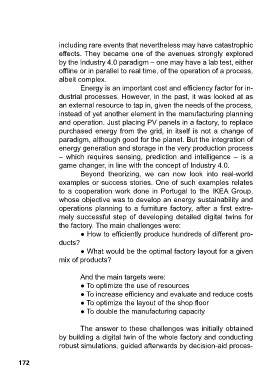Page 172 - UNAM-GCUB2022
P. 172
including rare events that nevertheless may have catastrophic
effects. They became one of the avenues strongly explored
by the Industry 4.0 paradigm – one may have a lab test, either
offline or in parallel to real time, of the operation of a process,
albeit complex.
Energy is an important cost and efficiency factor for in-
dustrial processes. However, in the past, it was looked at as
an external resource to tap in, given the needs of the process,
instead of yet another element in the manufacturing planning
and operation. Just placing PV panels in a factory, to replace
purchased energy from the grid, in itself is not a change of
paradigm, although good for the planet. But the integration of
energy generation and storage in the very production process
– which requires sensing, prediction and intelligence – is a
game changer, in line with the concept of Industry 4.0.
Beyond theorizing, we can now look into real-world
examples or success stories. One of such examples relates
to a cooperation work done in Portugal to the IKEA Group,
whose objective was to develop an energy sustainability and
operations planning to a furniture factory, after a first extre-
mely successful step of developing detailed digital twins for
the factory. The main challenges were:
● How to efficiently produce hundreds of different pro-
ducts?
● What would be the optimal factory layout for a given
mix of products?
And the main targets were:
● To optimize the use of resources
● To increase efficiency and evaluate and reduce costs
● To optimize the layout of the shop floor
● To double the manufacturing capacity
The answer to these challenges was initially obtained
by building a digital twin of the whole factory and conducting
robust simulations, guided afterwards by decision-aid proces-
172

